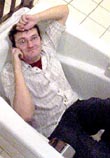|
|
This topic comprises 3 pages: 1 2 3
|
|
Author
|
Topic: The quality of grainy film lately.
|
|
|
|
|
|
|
|
|
|
|
|
|
|
|
Joe Beres
Jedi Master Film Handler

Posts: 606
From: Minneapolis, MN, USA
Registered: Nov 2000
|
 posted 05-04-2002 09:26 AM
posted 05-04-2002 09:26 AM




I think many of the films that you guys are talking about were intended to look grainy. In fact, I would argue that there is a small-scale trend towards grainy prints that began (not historically, but in recent years) with Eyes Wide Shut. Eyes Wide Shut was very grainy and I'm quite sure it was meant to be so. In my opinion, that aesthetic worked very well with the content of the film.Changing Lanes was also intentionally grainy. I would assume that they used graininess to try to further attempt to give the film an edgy, cinema verite aesthetic. In my opinion, Changing Lanes failed in this respect. See my post in the reviews section for my entire rant. I haven't seen EPII yet, but in that case, it sounds like it may have been a lab problem or some issue that arose with the digital to film transfer. Blackhawk Down, Seven and Panic Room were also most likely intentially grainy. I say intentionally as I can't speak for these filmmakers, nor have I read anything that would validate my statements. But let's remember that we are talking about professionals that are working with enormous budgets here. Yes, Super 35 will tend to yield a more grainy anamorphic image, but these people have and know the ways to avoid the grainy look of the final print: slower, finer stocks, more light, etc. If they didn't want their films to look like they do, more often than not, they wouldn't. I am exaggerating a bit to make my point, as I am sure that even in the super high budget world of Hollywood, things don't always come out the way they intend, but more often than not, these filmmakers and cinematographers have access to the money and tools they need to achieve whatever look the want to.
| IP: Logged
|
|
Frank Angel
Film God

Posts: 5305
From: Brooklyn NY USA
Registered: Dec 1999
|
 posted 05-04-2002 09:30 AM
posted 05-04-2002 09:30 AM





It is not so much the Super 35 as it is the mass produced release prints, made at super high speeds (you can't be running printers at near real-time speed if you need 3000 prints to meet a release date deadline and have only a month lead time). And then there is the problem that has been created a kind of bad by-product of the fast film stocks now available, n that their availability takes pressure off the young lighting directors to use conventional key, back, and fill lights as was done for decades. With fast stocks they can get away with cheap down and dirty lighting techniques. They can use much less in the way of heavy duty lighting which would normally allow slower, finer grain stocks to be used with their deep, rich color saturation and very fine grain. A very traditional filmmaker, Richard Haines (not sure if he visits this forum, but posts regularly on the 35mm Forum), has some wonderful rants about how the new crop of directors have pretty much abandonded the conventional way films were lit, thus producing this current crop of murky, sometimes gray and desaturated films. Also evidently they now use mulitple internegatives that make the final release prints more generations away from the camera negative than was done in the past -- a great contributor to the degraded look of today's films, according to Haines. We just ran two "show prints" of MOULIN ROUGE and SW Ep 1 (I believe these are struck directly from the camera negative or at least from an internegative closer to the camera negative than the mass produced regular release prints. They were gorgeous. You could almost believe you were watching technicolor or 70mm, the sharpness is that dramatic over conventional release prints. And once you see a show print next to a regular print, you will immediately see how impressive 35mm technology really is.
Using digital elements is not helping matters either. I just saw LORD OF THE RINGS (yah, I know, I am not enamored of seeing films when they are first released -- I wait until they are just about played out so I am guaranteed a good seat -- almost like a private screening!) and the insertion of digital effects was about as obvious as day and night-- now we are in focus, now we are not. It's great that CGI can do anything the imagination can congure up; now all they need to do is to figure out how to get it in focus.
| IP: Logged
|
|
|
|
|
|
Michael Barry
Jedi Master Film Handler

Posts: 584
From: Sydney, NSW, Australia
Registered: Nov 1999
|
 posted 05-04-2002 11:05 AM
posted 05-04-2002 11:05 AM




Ken,A 'show print' is a print which has been assigned for special screenings and is usually technically superior to the general print run of a given title. The higher quality can be achieved, for example, by printing directly from the camera negative, and/or by very careful lab work. Of course, general print runs can also be of excellent quality (minimal loss in steadiness and sharpness) when all the printing steps are done accurately. Sadly, this is not always the case. High-speed printing is often cited as the reason for poor quality general release prints, but this isn't so. Very high quality high-speed contact prints can be made once the internegative elements have been produced correctly.
| IP: Logged
|
|
|
|
|
|
|
|
|
|
All times are Central (GMT -6:00)
|
This topic comprises 3 pages: 1 2 3
|
Powered by Infopop Corporation
UBB.classicTM
6.3.1.2
The Film-Tech Forums are designed for various members related to the cinema industry to express their opinions, viewpoints and testimonials on various products, services and events based upon speculation, personal knowledge and factual information through use, therefore all views represented here allow no liability upon the publishers of this web site and the owners of said views assume no liability for any ill will resulting from these postings. The posts made here are for educational as well as entertainment purposes and as such anyone viewing this portion of the website must accept these views as statements of the author of that opinion
and agrees to release the authors from any and all liability.
|

 Home
Home
 Products
Products
 Store
Store
 Forum
Forum
 Warehouse
Warehouse
 Contact Us
Contact Us




 Printer-friendly view of this topic
Printer-friendly view of this topic


















